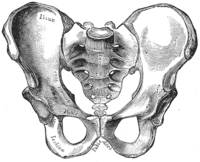
Photo from wikipedia
BACKGROUND Transperineal ultrasound (TPUS) is a valuable imaging tool for evaluating patients with pelvic floor disorders, including pelvic organ prolapse (POP). Currently, measurements of anatomical structures in the mid-sagittal plane… Click to show full abstract
BACKGROUND Transperineal ultrasound (TPUS) is a valuable imaging tool for evaluating patients with pelvic floor disorders, including pelvic organ prolapse (POP). Currently, measurements of anatomical structures in the mid-sagittal plane of 2D and 3D US volumes are obtained manually, which is time-consuming, has high intra-rater variability, and requires an expert in pelvic floor US interpretation. Manual segmentation and biometric measurement can take 15 minutes per 2D mid-sagittal image by an expert operator. An automated segmentation method would provide quantitative data relevant to pelvic floor disorders and improve the efficiency and reproducibility of segmentation-based biometric methods. PURPOSE Develop a fast, reproducible, and automated method of acquiring biometric measurements and organ segmentations from the mid-sagittal plane of female 3D TPUS volumes. METHODS Our method used a nnU-Net segmentation model to segment the pubis symphysis, urethra, bladder, rectum, rectal ampulla, and anorectal angle in the mid-sagittal plane of female 3D TPUS volumes. We developed an algorithm to extract relevant biometrics from the segmentations. Our dataset included 248 3D TPUS volumes, 126/122 rest/Valsalva split, from 135 patients. System performance was assessed by comparing the automated results with manual ground truth data using the Dice similarity coefficient (DSC) and average absolute difference (AD). Intra-class correlation coefficient (ICC) and time difference were used to compare reproducibility and efficiency between manual and automated methods respectively. High ICC, low AD and reduction in time indicated an accurate and reliable automated system, making TPUS an efficient alternative for POP assessment. Paired t-test and non-parametric Wilcoxon signed-rank test were conducted, with p < 0.05 determining significance. RESULTS The nnU-Net segmentation model reported average DSC and p values (in brackets), compared to the next best tested model, of 87.4% (<0.0001), 68.5% (<0.0001), 61.0% (0.1), 54.6% (0.04), 49.2% (<0.0001) and 33.7% (0.02) for bladder, rectum, urethra, pubic symphysis, anorectal angle, and rectal ampulla respectively. The average ADs for the bladder neck position, bladder descent, rectal ampulla descent and retrovesical angle were 3.2mm, 4.5mm, 5.3mm and 27.3°, respectively. The biometric algorithm had an ICC >0.80 for the bladder neck position, bladder descent and rectal ampulla descent when compared to manual measurements, indicating high reproducibility. The proposed algorithms required approximately 1.27 seconds to analyze one image. The manual ground truths were performed by a single expert operator. In addition, due to high operator dependency for TPUS image collection, we would need to pursue further studies with images collected from multiple operators. CONCLUSIONS Based on our search in scientific databases (i.e., Web of Science, IEEE Xplore Digital Library, Elsevier ScienceDirect and PubMed), this is the first reported work of an automated segmentation and biometric measurement system for the mid-sagittal plane of 3D TPUS volumes. The proposed algorithm pipeline can improve the efficiency (1.27 seconds compared to 15 minutes manually) and has high reproducibility (high ICC values) compared to manual TPUS analysis for pelvic floor disorder diagnosis. Further studies are needed to verify this system's viability using multiple TPUS operators and multiple experts for performing manual segmentation and extracting biometrics from the images. This article is protected by copyright. All rights reserved.
Journal Title: Medical physics
Year Published: 2023
Link to full text (if available)
Share on Social Media: Sign Up to like & get
recommendations!